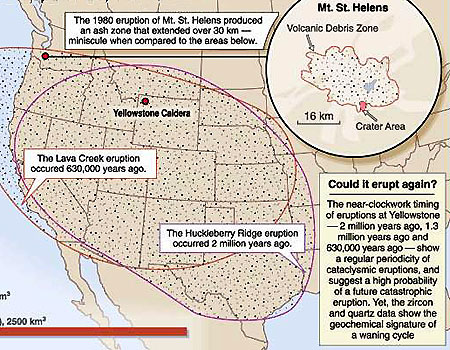Apr 13 2011
The Yellowstone Supervolcano
Did you know that there is a supervolcano hiding beneath Yellowstone National Park? I know scientists frequently delight in telling the public all the horrible ways in which we can be killed, massive damage can be done, or even how the entire human civilization can be wiped out. (My friend, Phil Plait, even wrote an entire book dedicated to the topic – Death from the Skies). It’s a good hook for a scientific discussion – we have an instant morbid fascination with the prospect of epic disaster.
The supervolcano, as the name implies, is a really big volcano. In the past the Yellowstone supervolcano has erupted, to devastating effect. And it will erupt again some day. It’s just a matter of time. Supervolcano eruptions can be so big that they have even been blamed for mass extinctions in the past.
Yellowstone is over what geologists call a hotspot – an area where the hot magma of the molten mantle rises close to the surface, collecting in a magma chamber. At Yellowstone this hotspot is what is causing all the hot springs and geysers. This hotspot is actually stationary, but the North America plate is moving to the west-southwest over the hotspot, making it seem as if is moving to the east-northeast – now over the states of Wyoming, Montana, and Idaho.
Scientists have been mapping this hotspot, and recently they have discovered that the magma plume under Yellowstone is probably larger than was previously thought. Prior techniques for measuring the plume used seismic waves. The recent study used electrical conductance – imaging those parts of the rock that contain briny water (which conducts electricity), and is associated with the plume.
It’s not surprising that the two techniques produced different images, since they are looking at different physical properties. The new data suggests, however, that the magma plume is probably larger than the seismic imaging revealed.
This does not necessarily mean that Yellowstone is any more dangerous than we already thought it was. We know of several large eruptions (supereruptions, of course) of Yellowstone – 2.1, 1.3, and 0.64 million years ago. Based upon this pattern, it looks as if we might be due for another big one. Although this could still mean tens of thousands of years from now. Geologists feel that the probability of an eruption in the next few thousand years is actually quite low.
The pattern is probably real, in that pressure slowly builds up in the magma chamber and then is explosively released. There are many smaller eruptions, however, and this releases pressure, making the timing of bigger eruptions more variable. The last such smaller eruption occurred about 70,000 years ago.
 Above is a graphic of the eruption debris field of the recent Yellowstone supereruptions. It’s difficult to imagine an eruption of such magnitude. The effects on weather and air quality would of course extend much beyond the debris fields demarcated above. The biggest eruptions also result in what are called caldera – and there are several in relation to Yellowstone. Essentially the magma chamber erupts and quickly empties, causing the overlying land to sink down into the chamber. The Yellowstone Caldera is about 50 miles in diameter.
Above is a graphic of the eruption debris field of the recent Yellowstone supereruptions. It’s difficult to imagine an eruption of such magnitude. The effects on weather and air quality would of course extend much beyond the debris fields demarcated above. The biggest eruptions also result in what are called caldera – and there are several in relation to Yellowstone. Essentially the magma chamber erupts and quickly empties, causing the overlying land to sink down into the chamber. The Yellowstone Caldera is about 50 miles in diameter.
Caldera result from the most violent eruptions, which occur about once every million years or so. The violent explosions can also result in pyroclastic flows – rapidly movement walls of gas and rock that can move at 450 mph over a wide range. These can occur with normal volcanoes as well, but of course are much larger with supereruptions.
Supervolcanoes are both fascinating and frightening. Even though it would be cool, I of course hope I never get to see such an eruption (at least not on the Earth).
For those interested in more detail, here is a pretty thorough site on the Yellowstone volcano system.






